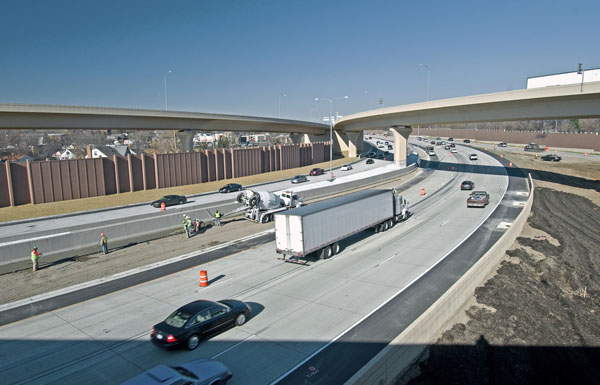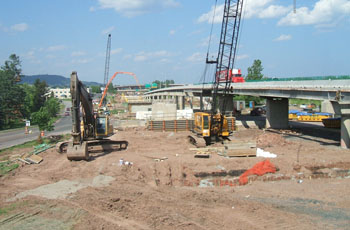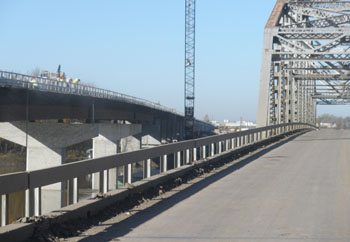By Nick Carpenter

Looking east, I-35W traffic moves at a steady pace through the Crosstown Commons and crosses under one of six flyover bridges constructed as part of the Crosstown project. Photo by David Gonzalez
|
The Interstate 35W/Hwy 62 Crosstown Commons in Minneapolis and Richfield leads a list of more than 150 state highway and bridge projects completed in 2010.
“The Crosstown project is just one of several high-profile projects across the state that will improve safety and mobility on Minnesota’s roads and bridges,” said Commissioner Tom Sorel. “Our crews were out resurfacing roads, replacing bridges, improving drainage systems, repairing guard rail, installing cable barriers, among other transportation projects vital to improving the quality of life for all Minnesotans.”
More than 150 of this year’s 235 state highway and bridge projects have been completed—the remaining projects will either be completed by the end of 2010 or continued into the next few years.
Work on the four-year $288 million Crosstown project is mostly finished and will be celebrated with a ribbon-cutting ceremony Nov. 13 at Pearl Park in Minneapolis. The project featured several improvements, including:
- Reconstruction of I-35W/Hwy 62, which will provide additional capacity on Hwy 62 through the Commons area
- Addition of a high-occupancy vehicle lane between 46th street in Minneapolis and I-494 in Richfield
- Addition of a general purpose lane between Hwy 62 and 46th street
The department identified and acquired 28 homes and businesses in the project area in order to make these improvements, which include the addition of:
- 26 new bridges
- 50 lane miles of pavement
- 85,000 feet of storm sewer
- More than one million square feet of noise wall
- A new transit station on I-35W at 46th street
Crews will continue to put the finishing touches on the project, such as landscaping and residential clean up.
In addition to the Crosstown Commons project, work on several other high-profile projects progressed. Here’s a look at some of those projects.

Work continues on the $67 million I-35 Mega Project in Duluth. Crews will replace three fracture-critical bridges and remove unused bridges as part of the project. Photo by Pat Huston |
The $67 million I-35 Mega Project in Duluth began this year and is already more than 50 percent completed.
The three-year project will reconstruct I-35, increase safety and reduce maintenance. Improvements include:
• Replacing pavement
• Improving drainage
• Replacing three fracture-critical bridges and removing unused bridges
• Installing Intelligent Transportation System components for improved emergency communications
• Replacing barriers and adding shoulders for increased safety
Despite restricting the major route into and through Duluth to a single lane in each direction and closing several ramps for the six-month construction season, the first year of construction has gone on without any major traffic issues and very few complaints from the traveling public, according to Roberta Dwyer, project manager.
“Even during major events like Grandma’s Marathon and the Tall Ships Festival, traffic has been flowing smoothly and safely,” Dwyer said. “There have only been a handful of minor crashes—none resulting in injury.”
The minimal number of traffic snarls can be attributed to a number of things, including the hiring of a local towing company and off-duty Minnesota State Troopers.
"We hired a tow truck company as part of the contract to quickly remove any stranded vehicles or debris on I-35," said Jim Sorenson, project supervisor. "In addition to that, off-duty state troopers were hired to help enforce the work zone speed limit and deal with prohibited truck traffic that ignored the posted detour."
The project is scheduled to open to four lanes of traffic Nov. 4. Work will resume in April 2011, again restricting travel to one lane in each direction for the remainder of the 2011 construction season. A small amount of ramp work will continue in 2012, with final project completion scheduled for June 30, 2012.
Two separate bridges were also completed this year—the I-494 Wakota Bridge in South St. Paul and the Hwy 11 Drayton-Robbin Bridge spanning the Red River in northwestern Minnesota.
After eight years of construction, the $300 million I-494 Wakota Bridge opened fully to traffic in July. Construction of the westbound bridge began in 2002 and was completed in 2006. Due to a design error, construction of the eastbound bridge was delayed until 2008.
The new Wakota Bridge features five traffic lanes in each direction—compared to the old bridge, which had two lanes in each direction, no sidewalks and narrow shoulders.
The project also included local road improvements, construction of two pedestrian/bicycle overpasses and trails. In addition, I-494 in the east Twin Cities Metro area will soon provide a reconstructed corridor from the airport all the way to I-94 that will accommodate projected future traffic capacity.
“This bridge will reduce congestion in this corridor and serve the public well for a long time,” Sorel said. “It should enhance the quality of life for all those who travel the bridge every day.”

As seen from the old Minnesota Hwy 11/North Dakota Hwy 66 bridge over the Red River, the new bridge connecting Robbin, Minn., and Drayton, N.D, cost $32 million to complete. The old bridge, built in 1954, is scheduled to be demolished this winter. Photo by Roger Hille |
About 350 miles northwest of the Wakota Bridge, crews recently finished worked on the Minnesota Hwy 11/North Dakota Hwy 66 bridge over the Red River between Robbin, Minn., and Drayton, N.D.
The joint-state project, which began in 2008, cost $32 million to complete. Each state contributed $16 million to the construction cost.
Crews had to replace the existing 1950s-era bridge because it was structurally deficient and weight restricted, according to Roger Hille, District 2 bridge engineer and the department’s project liaison to North Dakota during construction.
"The old bridge did not meet the transportation needs of the region due to the heavier loads of the current generation and the disruption of service during spring floods," Hille said. "Replacing the bridge was necessary in order to keep the highway in service."
Strong partnerships were required to transform the bridge replacement project from concept to reality.
"Both North Dakota and Mn/DOT prioritized the project and partnered throughout the programming, design and construction process, with North Dakota taking the lead,” Hille said. “The central bridge offices and districts of each transportation department contributed and a productive and effective partnership was forged.”
Other progressing and recently completed projects around the state include:
- Hwy 95 roundabout project in Princeton—work will be completed by mid-November. In spring 2011, crews will return to complete landscaping and permanent road markings.
- Hwy 55 reconstruction project near Glenwood—work is completed on a resurfacing and bridge replacement project between Glenwood and the Grant/Douglas county line.
- Hwy 14 between Waseca and Owatonna—work is progressing on the multi-year reconstruction of Hwy 14, which includes a new interchange at I-35. Construction is ongoing and is scheduled for completion in June 2012.
- Hwy 23 bypass project in Paynesville—work is well underway on the three-year Hwy 23 bypass project. Construction began last spring and is scheduled for completion in August 2012.
Although the majority of 2010 construction work is coming to an end, work on several projects throughout the state will continue through the winter as weather permits.
For a complete list of recently completed projects, and those still underway, visit http://www.dot.state.mn.us/roadwork/current.html. |



